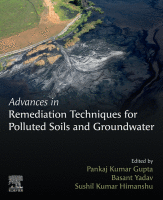Browse content
Table of contents
Actions for selected chapters
- Full text access
- Book chapterAbstract only
Chapter 1 - Flow and movement of gaseous pollutants in the subsurface: CO2 dynamics at a carbon capture and storage site
Shachi and Anuradha Garg
Pages 1-20 - Book chapterAbstract only
Chapter 2 - Column adsorption studies for the removal of chemical oxygen demand from fish pond wastewater using waste alum sludge
Muibat D. Yahya, Ibrahim A. Imam and Saka A. Abdulkareem
Pages 21-48 - Book chapterAbstract only
Chapter 3 - Farm management practices for water quality improvement: economic risk analysis of winter wheat production in the Southern High Plains
Yubing Fan and Sushil Kumar Himanshu
Pages 49-66 - Book chapterAbstract only
Chapter 4 - Bioremediation of contaminated soils by bacterial biosurfactants
Sabah Fatima, Muzafar Zaman, ... Tahir Ahmad Sheikh
Pages 67-85 - Book chapterAbstract only
Chapter 5 - Evaluation of machine learning-based modeling approaches in groundwater quantity and quality prediction
Madhumita Sahoo
Pages 87-103 - Book chapterAbstract only
Chapter 6 - Microbial consortium for bioremediation of polycyclic aromatic hydrocarbons polluted sites
Pankaj Kumar Gupta
Pages 105-124 - Book chapterAbstract only
Chapter 7 - Fate, transport, and bioremediation of PAHs in experimental domain: an overview of current status and future prospects
Pankaj Kumar Gupta, Manik Goel, ... Ram N. Bhargava
Pages 125-139 - Book chapterAbstract only
Chapter 8 - Mathematical modeling of contaminant transport in the subsurface environment
Abhay Guleria and Sumedha Chakma
Pages 141-169 - Book chapterAbstract only
Chapter 9 - Impacts of climatic variability on subsurface water resources
Pankaj Kumar Gupta, Brijesh Kumar Yadav and Devesh Sharma
Pages 171-189 - Book chapterAbstract only
Chapter 10 - Microplastic in the subsurface system: Extraction and characterization from sediments of River Ganga near Patna, Bihar
Rashmi Singh, Rakesh Kumar and Prabhakar Sharma
Pages 191-217 - Book chapterAbstract only
Chapter 11 - Assessment of long-term groundwater variation in India using GLDAS reanalysis
Swatantra Kumar Dubey, Preet Lal, ... Aditya Kumar Dubey
Pages 219-232 - Book chapterAbstract only
Chapter 12 - Emerging contaminants in subsurface: sources, remediation, and challenges
Anuradha Garg and Shachi
Pages 233-257 - Book chapterAbstract only
Chapter 13 - Selenium and naturally occurring radioactive contaminants in soil–water systems
Pankaj Kumar Gupta, Gaurav Saxena and Basant Yadav
Pages 259-267 - Book chapterAbstract only
Chapter 14 - Understanding and modeling the process of seawater intrusion: a review
Lingaraj Dhal and Sabyasachi Swain
Pages 269-290 - Book chapterAbstract only
Chapter 15 - Prioritization of erosion prone areas based on a sediment yield index for conservation treatments: A case study of the upper Tapi River basin
Santosh S. Palmate, Kumar Amrit, ... Sushil Kumar Himanshu
Pages 291-307 - Book chapterAbstract only
Chapter 16 - Advances in hydrocarbon bioremediation products: natural solutions
Pankaj Kumar Gupta
Pages 309-318 - Book chapterAbstract only
Chapter 17 - Nitrate-N movement revealed by a controlled in situ solute injection experiment in the middle Gangetic plains of India
Pankaj Kumar Gupta, Basant Yadav, ... Alison Parker
Pages 319-335 - Book chapterAbstract only
Chapter 18 - Integrated water resources management in Sikta irrigation system, Nepal
Rituraj Shukla, Ishwari Tiwari, ... Ramesh P. Rudra
Pages 337-359 - Book chapterAbstract only
Chapter 19 - Hydrocarbon pollution assessment and analysis using GC–MS
Pankaj Kumar Gupta
Pages 361-377 - Book chapterNo access
Index
Pages 379-388
About the book
Description
Advances in Remediation Techniques for Polluted Soils and Groundwater focuses on the thematic areas for assessment, mitigation, and management of polluted sites. This book covers advances in modelling approaches, including Machine Learning (ML)/ Artificial Intelligence (AI) applications; GIS and remote sensing; sensors; impacts of climate change on geogenic contaminants; and socio-economic impacts in the poor rural and urban areas, which are lacking in a more comprehensive manner in the previous titles. This book encompasses updated information as well as future directions for researchers working in the field of management and remediation of polluted sites.
Advances in Remediation Techniques for Polluted Soils and Groundwater focuses on the thematic areas for assessment, mitigation, and management of polluted sites. This book covers advances in modelling approaches, including Machine Learning (ML)/ Artificial Intelligence (AI) applications; GIS and remote sensing; sensors; impacts of climate change on geogenic contaminants; and socio-economic impacts in the poor rural and urban areas, which are lacking in a more comprehensive manner in the previous titles. This book encompasses updated information as well as future directions for researchers working in the field of management and remediation of polluted sites.
Key Features
- Introduces fate and transport of multi-pollutants under varying subsurface conditions
- Details underlying mechanisms of biodegradation and biodetoxification of geogenic, industrial and emerging pollutants
- Presents recent advances and challenges in assessment, water quality modeling, uncertainty, and water supply management
- Provides authoritative contributions on the diverse aspects of management and remediation from leading experts around the world
- Introduces fate and transport of multi-pollutants under varying subsurface conditions
- Details underlying mechanisms of biodegradation and biodetoxification of geogenic, industrial and emerging pollutants
- Presents recent advances and challenges in assessment, water quality modeling, uncertainty, and water supply management
- Provides authoritative contributions on the diverse aspects of management and remediation from leading experts around the world
Details
ISBN
978-0-12-823830-1
Language
English
Published
2021
Copyright
Copyright © 2022 Elsevier Inc. All rights reserved.
Imprint
Elsevier
